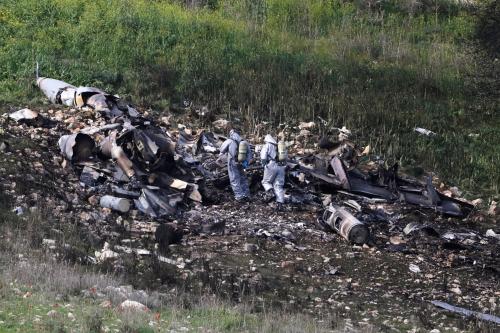In 1965, the British writer Patrick Seale published his classic “The Struggle for Syria: 1945-1958.” His history of the Syrian Republic’s first 13 years depicted a fragile, weak state, torn by domestic conflicts and buffeted by more powerful regional and international actors. Seale argued that Syria was the prize that these external actors were seeking in order to establish hegemony in the core area of the Middle East. Today, Syria is facing a very similar situation, seven years after what began as a peaceful uprising transformed into a vicious civil war with a fierce competition between regional and international actors over Syria’s future. And as the internal dimension seems to be abating after the capture of Aleppo in late 2016, the regional and international conflicts have been exacerbated.
In Seale’s history of Syria, the two Hashemite monarchies in Iraq and Jordan sought to take control of the Syrian state while their Arab rivals, the Egyptian-Saudi axis, fought to frustrate these efforts. Britain and France, the former colonial powers, intervened in Syrian politics directly or through their Arab partners. The United States intervened in Syrian politics when the CIA collaborated with Syria first military dictator, Husni Zaim. The Soviet Union was not yet an actor in this arena, and Turkey was looking west rather than south. The Syrian state was controlled by the old nationalist urban Sunni elite that had fought the French for the unity and independence of a country whose boundaries were arbitrarily established by the European colonial powers. The process of integrating the outlying areas, the Alawite and Druze regions in the west and the south and the Jazeera in the northeast, proved difficult. The parliamentary system did not function well, and the rise of radical ideological parties and the military’s intervention in politics further fragmented and radicalized the country’s politics. Finally, the Syrians found refuge by merging their country with Egypt in the United Arab Republic.
Syria seceded from that failed union in 1961 and struggled for several years to consolidate its renewed independent existence. The Ba’ath party was brought to power in March 1963 by a military cabal affiliated with the party. A member of that cabal, Hafez al-Assad, finally took over in November 1970 and ruled Syria for 30 years until his death in June 2000. Assad built the Syrian state and turned it into a major regional actor. He also excelled in exploiting the Soviet-American rivalry and in presenting himself as the champion of “resistance” (muqawama) to both Israel and the West. Under the patina of a revolutionary Arab regime, Assad built a neo-patrimonial system, with his family and Alawite community as its core. The epitome of this neo-patrimonialism was the succession: When Assad died, his son Bashar succeeded him. Hafez al-Assad’s ability to control Syria for 30 years and his son’s ability to stay in power for 11 years, to date, derive also from the fact that their power did not rely exclusively on the Alawite minority. Hafez al-Assad built a patronage system, as well as bridges to the Sunni bourgeoisie, and also enjoyed the support of other minority groups, such as the Christians and the Druze.
Bashar maintained, with some slight modifications, the system his father built. He was unwilling, and in some cases unable, to introduce political and economic reforms. When the “Arab Spring” broke out in late 2010, toppled three dictatorial regimes and threatened others, Bashar al-Assad deluded himself into believing that his image as the symbol of “resistance” would enable him and his regime to survive the storm. He was wrong, and the Syrian rebellion broke out in March 2011 and became the dominant issue in Middle Eastern politics for the next seven years.
Ironically, the outbreak of the Syrian rebellion pushed Syria back into the situation it had faced between 1945 and 1958. The domestic conflict between regime and opposition was soon compounded by regional and international conflicts over Syria’s future.
In the region, the core of the conflict has been an Iranian-Saudi or Shiite-Sunni conflict, with Iran and its proxies (the Lebanese Hezbollah and other Shiite militias) protecting the regime and Saudi Arabia and other Gulf states supporting different opposition groups. Turkey has played its own important role: in hosting the headquarters of the opposition, allowing transit of foreign fighters into Syria, and occupying parts of northern Syria in order to check the Kurdish ambitions for autonomy and continuity. Israel, until recently, played a modest role in the Syrian crisis.
Internationally, Russia has played a crucial role by giving Assad diplomatic support and, as of 2015, via a military intervention, primarily through its air force. It was this Russian intervention that enabled the regime to recapture the city of Aleppo in December 2016 and to turn the tide of the domestic conflict. The United States under both Presidents Obama and Trump chose to play a more limited role by extending some support to opposition groups and by investing its most important efforts in fighting the Islamic State.
In March 2018, seven years after the outbreak of the Syrian rebellion, Assad is in control of at least half of Syria’s territory, and with Russian and Iranian support seeks to grind down the remaining opposition strongholds and to gradually extend his control over most, if not all, of Syria’s national territory. The jihadi opposition is still in control of the city and region of Idlib in northwestern Syria. The Kurds dominate some 15 to 20 percent of the country’s territory along the Turkish and Iraqi borders. The United States has supported the Kurds, maintaining at least 2,000 special forces in their territory; Turkey opposes them, occupying several areas along its border with Syria in order to deny the Kurds territorial continuity. In the southwestern part of the country, Iran is trying to install its own troops and bases, as well as Shiite militias, in order to extend the line of confrontation with Israel from the Mediterranean along the Lebanese-Israeli border into the Golan. Israel is determined to check this process and collided with both Iran and the regime’s forces in mid-February. Saudi Arabia and the other conservative Sunni states share Israel’s opposition to Iran’s presence and influence in Syria, and act to counter it primarily by continuing their support for Sunni Islamist groups. Meanwhile, the Islamic State has been militarily defeated in Syria, but not eradicated.
The struggle for Syria will continue. Russia will continue to support the regime and keep its military—primarily naval and aerial bases—in the country. Iran’s ambitions go further. In addition to military support and the importation of Shiite militias from Lebanon, Iraq, Pakistan and Afghanistan, the Iranians are seeking to expand their influence on Syrian society, economy, and politics. America’s European allies are committed, in principle, to a political and diplomatic solution to the Syrian crisis and to Assad’s eventual departure, but their influence is limited and they are likely to seek a role for European cooperation in the reconstruction of Syria. Financing this reconstruction could be provided by the Gulf Sunni states, but they are likely to use the resources only in the service of their political ends. Israel realizes that it is on a collision course with Iran and that its delicate coordination with Russia that has thus far prevented a Russian-Israeli collision could collapse at any time.
A key question concerns the Trump administration’s policy. The president’s tough anti-Iranian rhetoric has so far not translated into real anti-Iranian action in Syria. America’s limited military presence in northeastern Syria and its alliance with the Kurds gives it limited influence in the struggle over shaping Syria’s future. Secretary of State Tillerson, in a speech he delivered in mid-January, presented Washington’s strategy in Syria, but the goals he set for his country’s policies are not realistic. As the Syrian crisis enters its eighth year, its most horrific aspects—the mass killing, the destruction, and the waves of refugees—seem to be over. Now, the conflict focuses more and more on the country’s future as a pawn in the struggle between the principal regional and international actors.










Commentary
The struggle for Syria, Chapter Two
February 20, 2018